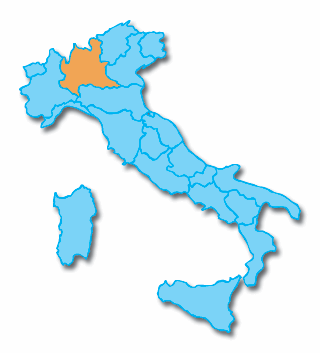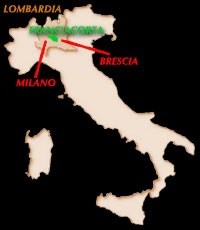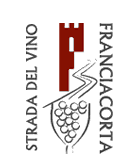FRANCIACORTA DOCG
.
Franciacorta will be official Sparkling Wine at EXPO 2015 in Milan 01 Maj - 31 october
PRODUCING AREA AND DENOMINATIONS
Franciacorta is a name of a geographical area in the north of Italy, in Lombardia (Lombardy) region, at 70 km east of Milan. The biggest city of Franciacorta is Brescia, and other 18 villages are included in this area:: Adro, Capriolo, Cazzago San Martino, Cellatica, Coccaglio, Cologne, Corte Franca, Erbusco, Gussago, Iseo, Monticelli Brusati, Ome, Paderno Franciacorta, Paratico, Passirano, Provaglio d'Iseo, Rodengo-Saiano e Rovato.
.

Lombardia Region
.

Franciacorta Producing Area
.

Franciacorta Producing Area
.
The rolling hills of this region were shaped by glacial action. The soil drains well, and is ideal for the cultivation of grapes and winemaking. The weather is mild and constant due to its location south of the foothills of the Alps and the tempering presence of largest Italian lakes. To publicize wine tourism the district established in 2001, Strada del Vino Franciacorta (Franciacorta wine route).
The name Franciacorta, which is present in some documents since 1277, derives from curtes francae (the ancient name of this region) which means duty free court. Probably because in this region there were a duty free trade.
Since 1995, sparkling wines coming from this region have a DOCG mark. It has been the first Italian sparkling wine to obtain this denomination.
This is the mark of the consortium of Franciacorta wine and strada del vino di Franciacorta

PRODUCTION OF FRANCIACORTA
The grapes used in Franciacorta Sparkling wine are Chardonnay and/or Pinot Nero grapes. It s allowed to use Pinot Bianco grapes too for at most 50% of the blend.
Franciacorta sparkling wine is produced with the traditional method (please see the chapter about sparkling wine).
A minimum of eighteen months of slow bottle refermentation with yeasts contact will have to pass before it is disgorged, while for non-vintage Satèn and Rosé times are even longer: till twenty-four months. For vintage Franciacortas, the production protocol demands a minimum period of ageing on the yeasts in bottle of thirty months. Much more patience is needed to taste a Franciacorta Riserva: winemaking and maturation continue for at least sixty-seven months after the vintage, sixty of which are spent in bottle on the lees. The following flavour types are permitted: Undosed (Non dosato, Pas Dosé, Dosage Zèro, Nature), Extra Brut, Brut, Extra Dry, Sec and DemiSec
Franciacorta Satèn
The trademark Franciacorta Satèn was registered by the consortium in 1995 to identify this particular Franciacorta wine type. This name could be used only by producers which were members of the consortium. With the new production protocol (July 7th 2008) Franciacorta Satèn becomes actually a new wine type which can be produced by all the Franciacorta producers.
Blend: (mainly) Chardonnay and Pinot Bianco for at most 50% of the blend (blanc de blanc).
respect to other Franciacorta, Satèn presents lower pressure in the bottle, less than five atmospheres, which gives it its special softness in the mouth. Produced only in the Brut version.
Franciacorta Rosé
Blend: Chardonnay, Pinot Bianco, Pinot Nero (minimum 25%) grapes. Often Franciacorta Rosé have a quantity of Pinot Nero even higher than 25%.
Method: the white and red grapes are vinified separately. Franciacorta Rosé can be obtained from exclusively Pinot Nero base wine vinified with skin contact or from a blend of this wine with Chardonnay and/or Pinot Bianco base wine. The wine may be dosed to produce all flavour types.
the Pinot Nero grapes are vinified with sufficient skin contact to imbue the wine with the rosé hue desired.
Vintage Franciacorta (MILLESIMATO)
Winemaking: obtained at least 85% from base wines from a single vintage; winemaking and maturation continue for at least thirty-seven months after the vintage, thirty of which are spent in bottle on the yeasts to impart its intense fragrances and subtle, elegant aromas. Often, vintage Franciacorta remain on the lees for a much longer period than the minimum laid down by the production protocol. So Franciacorta Riserva springs up!
Uniqueness: the label indicates the year, or millesimo, of the harvest.
Franciacorta Riserva
It is a Vintage Franciacorta which can be a Satèn or Rosé too. It ages on yeasts for at least sixty months so it goes on the market after at least sixty-seven months (five years and a half) after the vintage. Since a lot of Franciacorta millesimato spend in bottle on the yeasts much more time than the canonical thirty months, we intended to enhance their value by identifying them in a specific type. Franciacorta Riserva represents the highest qualitative expression of the territory and of Franciacorta wine producers’ interpretative, as well as technical, capabilities.
HOW TO DRINK FRANCIACORTA
Franciacorta is a superb wine to drink through the meal or even alone. The various flavour types can be matched with an extremely wide range of foods and products. Each wine type has its own distinct personality. Should be Served in Franciacorta glasses or flute at a temperature of 8-10 °C.
Franciacorta has very fine, perlage; pale or intense straw yellow with greenish highlights; nuanced but distinct yeasty notes of crusty bread, accompanied by subtle clove-led spice-lifted hints of fresh and dried fruits, including almonds, hazelnuts and dried figs; pleasing savouriness and freshness on the palate.
Franciacorta Satèn has very fine, almost creamy perlage. more or less intense straw yellow with greenish highlights; nuanced but distinct fragrance of ripe fruit, accompanied by subtle notes of spring flowers and dried or roasted nuts, including almonds and hazelnuts; the palate reveals pleasing savouriness and freshness fusing with the deliciously soft texture, reminiscent of silk on skin. Satèn is one of the supreme expressions of Franciacorta’s harmony, appeal and flavour. Magic in a bottle.
In Franciacorta rosè, The Pinot Nero in the blend gives this Franciacorta its unique body and vigour.
Vintage (millesimati) Franciacorta have sensory and gustatory profiles that reflect the weather conditions during the growing year and the quality of the grapes from that particular vintage. The wine is obtained from grapes picked in very special climatic and harvest conditions that brought the bunches to an optimal uniform ripeness.




